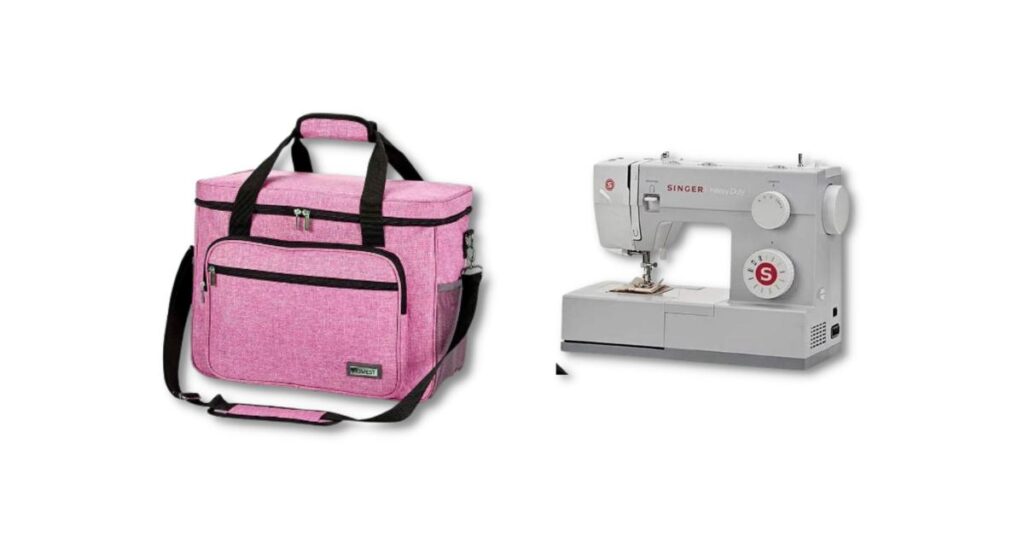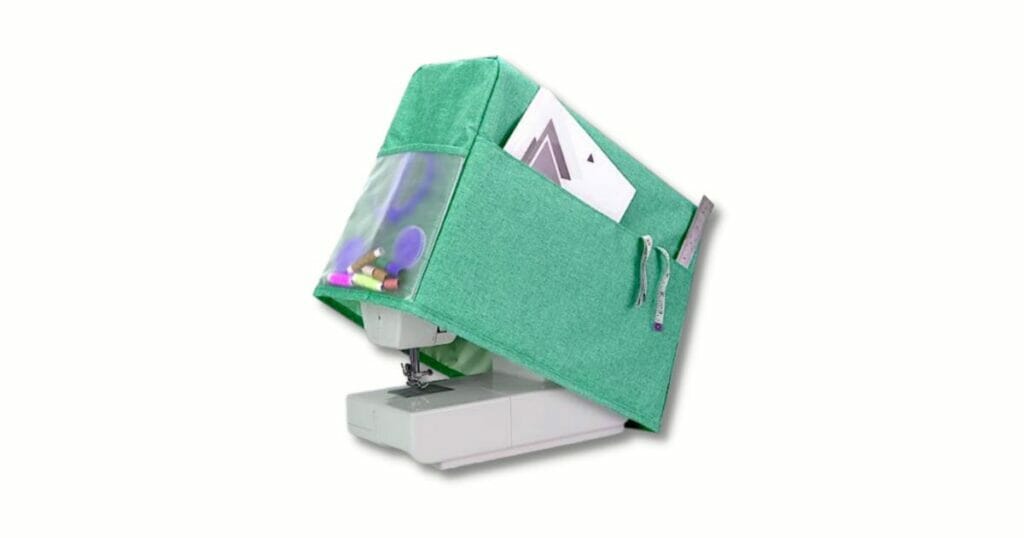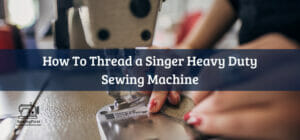Sewing machines are expensive investments. They’re also heavy and bulky. How do you store your sewing machine? Do you even bother?
Storing your sewing machine properly will save you space, prevent damage, and make it easy to access whenever needed. In this guide, I’ll teach you how to store your sewing machine safely and efficiently.
I’ll walk you through the whole process step-by-step and provide tips along the way.

Related Topic: How to Pack a Sewing Machine For Moving: A Step-by-Step Guide
Table of Contents
ToggleImportant Considerations
Before we get started, there are a few things you should know about storing your sewing machine:
- You can’t just throw any old thing in your sewing room.
- Your sewing machine may be damaged if you don’t take care of it.
- Leaving your machine unattended while you sleep or work is not safe.
- They might play with your sewing machine if you have kids.
- You must keep your sewing machine clean.
Before sharing a storage guide for a sewing machine, read how to get rust off vintage sewing machine
How to Store a Sewing Machine: Step-By-Step Guide
First, read an instruction manual for your sewing machine to get the required information regarding its storage.
Cleaning
There are many ways to clean your sewing machine. Some methods work better than others. And some methods are safer than others. Also, don’t forget to clean a sewing machine feet before using it.
The best way to clean your sewing machine is by hand. You can use an all-purpose cleaner like Simple Green or a specific cleaning agent for your machine.
Here are three sewing machine cleaning options
Use a steam cleaner
Steam cleaners use water and heat to remove dust and lint from your machine. The steam cleanser is gentle enough to avoid damaging delicate parts of your machine. Plus, steam cleaners are inexpensive.
use a piece of fabric to gently dry all the external parts of your sewing machine.
Use a vacuum cleaner
Vacuum cleaners suck up dirt and debris from your machine. This method works well for removing small amounts of dust and lint. However, vacuums aren’t great at sucking up large clumps of lint.
Use a brush
Brushes are effective at removing stubborn lint and dust from your machine. Brushing helps loosen any stuck particles before they become embedded in your fabric. the brush makes it easy to clean feed dogs, throat plate, and needle bar areas.
However, you can also some mild cleansers on your machine.
Oiling
Sewing machines need oil to keep them running smoothly. But not just any oil will work. The right type of oil will prevent friction between moving parts, which helps reduce wear and tear.
There are two main types of sewing machine oils: synthetic and natural. Synthetic oils are made from petroleum products, whereas natural oils come from plants. Both types of oils are available at most hardware stores.
Synthetic oils tend to last longer than natural oils, but they’re also more expensive. Natural oils are cheaper, but they may break down over time. So it depends on your budget and preference.
If you’re looking for a long-lasting solution, go with synthetic oil. However, if you prefer something that lasts a bit shorter, use natural oil instead.
Furthermore, If you’re looking for a reliable source of sewing machine oil, visit Amazon.com. They sell everything from sewing machine oil to sewing machine accessories.
When shopping online, search for “sewing machine oil.” You’ll find many options, including brands like Husqvarna, Brother, Singer, Janome, Pfaff, Bernina, and others.
Once you’ve found the right type of sewing machine oil, store it away in a cool dry place where it won’t freeze. Make sure you keep it out of direct sunlight, too.
Don’t use sewing machine oil that has been sitting around for months or years. Instead, buy a small bottle of sewing machine oil today and use it within six months.
How to Put an Oil in a Sewing Machine
To put oil into your sewing machine, follow these steps:
- Remove the top cover by lifting it off.
- Unscrew the front panel by turning it counterclockwise.
- Lift the front panel off by pulling it toward you.
- Open the access door by pushing it open.
- Pull the needle plate out of its slot.
- Pour the desired amount of oil into the reservoir. check throat plate and needle bar.
- Replace the needle plate.
- Screw the front panel back onto the machine.
- Close the access door.
- Turn the machine on.
Take some pieces of scrap fabric to test the machine if it is running smoothly.
Change the Needle and Threads of a Sewing Machine Before Storage
Sewing machines come with many different parts, including needles and threads. But before storing any sewing machine, change the needle and thread. This prevents damage to the machine and ensures that you’re ready to sew whenever you need to.
To change the needle and thread, First, lift the pressure foot to release the tension and then remove the bobbin case from the machine. Then, pull out the needle and replace it with another one. Next, take off the top cover and insert the new needle through the hole at the end of the needle holder. Finally, put the bobbin back in place.
Cover Your Sewing Machine with a Case
Sewing machines are expensive investments. They’re not cheap toys, after all. So protecting them is important. But sewing machine cases aren’t just for show. They actually protect your investment.
They keep your machine safe from dust, dirt, and moisture. And they prevent damage from falls and bumps. Plus, they help keep your machine clean and free of germs.
But there are many different kinds of sewing machine cases available. Some are made of plastic, some of the metal, and others of wood. Each type has its pros and cons.

Plastic Cases: Plastic cases are inexpensive and lightweight. However, they tend to crack easily and may warp over time. Also, they’re not very durable.
Metal Cases: Metal cases are heavy and sturdy. They’re great for storing large items, like power tools. But they’re too bulky to store small items, like sewing machines.
Wooden Cases: Wooden cases are strong and attractive. They’re also relatively inexpensive. But wooden cases are prone to warping and cracking.
If you’re looking for a case that protects your sewing machine, consider one that’s made of wood. Wood is stronger than plastic and metal. And it won’t warp or crack.
Also, make sure your case fits snugly around your sewing machine. This helps ensure that your machine stays protected.
And finally, cover your sewing machine with a protective fabric cover before putting it away. This prevents scratches and dents.
For presser feet, use a piece of cloth instead of a paper towel. Paper towels can leave residue behind. And cloth absorbs excess water.
Storage Area
If you have a home office, consider keeping your sewing machine there. This is especially true if you sew frequently. If you work at home, you may find yourself working late hours, leaving your sewing machine unattended.
If you have limited space, consider putting your sewing machine in a closet. Closets are great places to store clothes, shoes, and other items. However, closets aren’t ideal for sewing machines because they tend to collect dust and dirt.
If you have room for a dedicated sewing area, consider placing your sewing machine in a corner of your bedroom. This works well if you sew regularly since you won’t have to worry about your machine being left alone during the day.
Finally, if you have a large workshop or garage, consider moving your sewing machine to a separate room. This is particularly useful if you have multiple sewing machines, heavy-duty sewing machines, or industrial sewing machines like embroidery machines.
Storage Area and Weather Conditions
Sewing machines need to be stored properly. Otherwise, they could get damaged by extreme heat or cold.
Store your sewing machine in an area where temperatures remain constant year-round. For example, if you live in Alaska, don’t put your sewing machine on top of your refrigerator. The temperature inside your fridge fluctuates greatly.
Instead, place your sewing machine in a cool, dry location. Consider using a basement, attic, or garage. These areas are usually free from humidity and moisture.
Keep your sewing machine out of direct sunlight. Direct sunlight will cause your machine to overheat. So keep your sewing machine in a shaded area.
How to Store Sewing Machine Feet
When storing sewing machine feet, follow these tips:
- Use a soft material when covering your sewing machine feet. Cotton balls, tissue paper, and old sheets are all good options.
- Cover your sewing machine feet with a clean sheet. Then remove any excess material.
- Don’t let your sewing machine feet touch anything else. This includes walls, furniture, clothing, and even pets.
- Protect your sewing machine feet from getting wet. Moisture can damage them.
- Protect your sewing machine feet from dust and debris. Use a vacuum cleaner to clear the air around your sewing machine feet.
How to Store Antique Sewing Machine
Antique sewing machines are beautiful pieces of history. They’re also expensive and fragile. So how should you store them?
First off, never put antique sewing machines in the basement. The humidity down there is too high and can damage the machine. Instead, keep them in a dry place where they won’t rust out.
Next, take care not to drop or knock over any antique sewing machines. Even though they may seem heavy, they aren’t. And if you accidentally knock one over, don’t panic. Simply pick it back up and continue working.
Finally, clean your antique sewing machines regularly. Use a soft cloth to wipe away dust and dirt. Then use a vacuum cleaner to remove lint and hair. This will help prevent future problems.
Conclusion
Sewing machines are expensive investments, and storing them properly is essential to keeping them safe and running smoothly. This article provides tips on how to store sewing machines safely. It includes information on where to put your machine, what types of materials to use when storing your machine, and how to clean your machine regularly.
FAQs
Where to store a sewing machine during cold weather conditions?
If you live in a cold climate, you’ll want to store your sewing machine in a warm, dry space. If possible, try to find a spot that’s near a heater or furnace.
What type of fabric should I use for my sewing machine cover?
You can choose from cotton balls, tissue paper, old sheets, and more. But remember that cotton balls tend to absorb moisture.
How do I protect my sewing machine from water?
You can use plastic bags or other waterproof covers. Or you can wrap your machine in a tarpaulin. Just make sure that the tarp doesn’t have holes in it.
How often should I clean my sewing machine?
It depends on the type of sewing machine you own. Some models require less cleaning than others. But regardless of which model you have, you should clean your machine at least once every two months.
Do Brother sewing machines come with a cover case?
Yes, most Brother sewing machines include a protective cover. You just need to purchase one separately.
Is it possible to get a case cover from a sewing machine shop?
Yes, many shops sell sewing machine cases. But be careful about buying these items online. Many websites offer cheap products that look great but don’t last very long.





